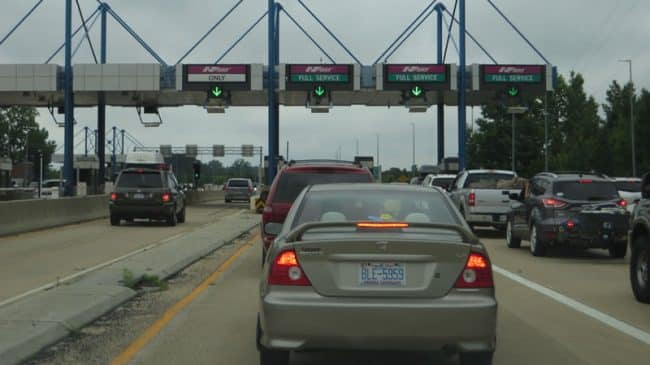Critics of the now-approved project to add express toll lanes to Interstate 77 in Charlotte, North Carolina make two arguments: (1) widening I-77 with a regular lane each way would provide greater congestion relief, and (2) the public-private partnership (P3) is a bad deal for taxpayers.
Express toll lanes make sense when an expressway is projected to have a long-term congestion problem due to ongoing economic growth and cannot be widened indefinitely. The more cars try to crowd into a regular lane, the slower they get – and eventually the flow rate gets as low as 800 cars/lane per hour in stop-and-go traffic. With an express toll lane, the idea is to use a price to prevent that overcrowding, letting in only enough cars to ensure free-flowing conditions – about 1,800 cars/lane per hour.
What would rush hour look like on I-77 about 20 years from now, if I-77 were widened with one regular lane each way (making five each way)? Assuming continued economic growth and congestion, each lane could well be at 800 cars/hour – or 4,000/hour for the five inbound lanes. Under the express lane alternative, the two express lanes each way could handle 1,800 cars each, and the three regular lanes 800 each, for a total rush-hour throughput of 6,000 cars/hour – 50 percent more than the nonpriced alternative.
Results like these are seen every day on formerly gridlocked I-95 in Miami, I-85 in Atlanta, and State Route 91 in Orange County, Calif., all of which are significantly less congested thanks to the addition of express toll lanes.
What about the P3 deal between Cintra and the North Carolina Department of Transportation (NCDOT)? Under this long-term contract, the company will finance, design, build, operate, and maintain the express lanes for 50 years. The estimated project cost is $648 million, with the state putting in up to $170 million and Cintra raising the rest, mostly by selling revenue bonds and getting a secondary loan from the federal TIFIA program – both backed by toll revenues, not taxpayers. Cintra is also investing $248 million in equity, on which it hopes to make a return if all goes well.
The benefits to motorists are several. First, NCDOT estimates it would have been 15 or 20 years before it had the money to build this much-needed improvement on its own, but thanks to the P3 investment, the new lanes will open in just three years. Second, if the project goes over budget, that is Cintra’s problem, not taxpayers’ problem. Third, proper maintenance of the new lanes is guaranteed for the next 50 years, paid for by Cintra out of toll revenues. And to minimize that expense, they have a powerful incentive to design and build durable pavement that will need less maintenance.
What are the downsides? The deal includes a provision that requires the DOT to compensate the company in the event that it adds (currently unplanned) free lanes that take traffic away from the toll lanes. It would be difficult to get investors to buy the revenue bonds without some protection against unlimited free competition.
And what if the project turns out to be a dud, with traffic and revenue way below what Cintra’s financing model predicts? There is no provision for the taxpayers to bail out the project. Instead, as has happened in several P3 cases, Cintra’s I-77 company would declare bankruptcy. Its investors would take the loss, not North Carolina taxpayers. The bondholders would sell the project for the most they could get – and the express lanes would remain in service under the new operator for the rest of the 50-year period.
Major congestion relief and taxpayer protection – it’s a combination we are seeing around the country.
Robert Poole is director of transportation policy at Reason Foundation. This article originally appeared in the Carolina Journal Online.

